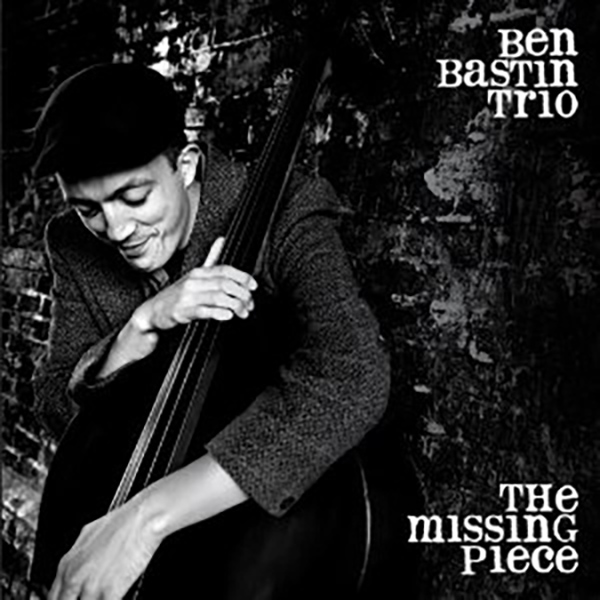
by Ian Mann
May 03, 2011
/ ALBUM
There's real scope and a commendable spirit of ambition about "The Missing Piece" that makes it more than just another trio date.
Ben Bastin Trio
“The Missing Piece”
(Pastiche Records PR0002)
Double bassist Ben Bastin is probably best known for his role in driving the band led by vocalist/guitarist/songwriter Sarah Gillespie, an outfit that also features the extraordinary talents of multi instrumentalist Gilad Atzmon. Bastin makes a significant contribution to both of Gillespie’s albums, “Stalking Juliet” (2008) and “In The Current Climate” (2011). He is also an important component in the success of the Gillespie group’s exciting live shows with a charismatic stage presence of his own.
“The Missing Piece” reveals Bastin’s talents as a band leader and composer. He heads an exciting trio featuring two rising stars of the UK jazz scene in pianist John Turville and drummer Josh Blackmore. Turville also leads his own trio and his album “Midas” was one of the outstanding releases of 2010. Blackmore has earned himself a considerable reputation for his work with Tom Cawley’s piano trio Curios and with the guitar/organ combo Troyka featuring guitarist Chris Montague and keyboardist Kit Downes.
Bastin’s bass led “piano trio” may initially invite comparisons with Jasper Hoiby’s Phronesis but “The Missing Piece” expands its remit by including contributions from violinist Raven Bush, cellist Danny Keane and vocalist Amelia Tucker. In this respect the album is similar in conception to Kit Downes’ recent “Quiet Tiger” album where the work of the core trio was substantially augmented by the contributions of the guest musicians.
This album opens, appropriately enough, with the sound of Bastin’s bass ushering the trio into “In Pursuit Of Old Age”, one of eight Bastin originals on the album. Many have commented on the tremendous rhythmic power Bastin adds to the Gillespie band but the emphasis here is on subtlety and the interplay between the three protagonists. Bastin has also come up with some lovely tunes, the album is consequently less groove based than Bastin’s work elsewhere might suggest, a fact that also rather undermines the Hoiby comparison. Bastin’s solo here is virtuosic and highly dexterous but it’s also inherently musical and without any hint of grandstanding, qualities he brings into play throughout the entire album.
“Arthur” adds violin and cello to the core trio. It’s a stunningly lovely piece of chamber jazz with the strings superbly integrated into the group sound. Turville is at his most lyrical, Bastin’s solo combines both lightness and resonance and Blackmore’s brushwork is delightfully supple throughout.
The title track has an almost hypnotic quality courtesy of a repeated Turville piano figure. There’s also a deeply resonant solo from Bastin and more fine work from Turville, all supported by the quiet chatter of Blackmore’s brushed drums.
“As It Was” welcomes the strings back into the fold to add extra colour and texture to the group sound. Turville’s solo is one of his most expansive to date but the strings come into their own on Bastin’s solo with Bush’s keening violin and Keane’s melancholy cello the perfect foils to the leader’s plucked bass.
“Another One For Louise” is an unashamedly romantic ballad sensitively played by the trio with Bastin at his most lyrical. By way of contrast “Touring Torino” is lively and sprightly with a gently shuffling groove and expansive solos from Bastin and Turville. Both wear their virtuosity lightly and exhibit a pleasing lightness of touch as Blackmore responds to their every move.
The only outside piece on the album is the song “Scissors Paper Stone”, written and movingly sung by Amelia Tucker. The vocalist displays a quirky vulnerability on the kind of song that with the right exposure and a little editing could even become a left field hit. Instrumentally there’s a flowing solo from Turville in the latter stages of the piece as the three instrumentalists take the chance to stretch out.
An element of quirkiness also imbues the trio piece “Wasn’t Sure” with its now customary solos from both Turville and Bastin. Both take the opportunity to stretch out above the chatter of Blackmore’s drums but the young percussionist has plenty more to say , laying down some very contemporary grooves and enjoying something of a feature himself in the tune’s latter stages.
The closing “Not Untitled” adds Tucker’s ethereal, soaring wordless vocals to the trio sound in a piece builds from a simple E.S.T. style piano figure to something much more epic and dramatic whilst taking in impressive solos from Bastin and Turville en route.
“The Missing Piece”, Bastin’s second album as a leader (there was also an earlier live recording), not only establishes the young leader as a masterful bass soloist but also reveals him to be a composer of considerable ability and promise. There’s real scope and a commendable spirit of ambition about “The Missing Piece” that makes it more than just another trio date.
Even so it’s probably not distinctive enough to lift Bastin into the major league just yet, despite it being a very good showcase for his talents. However with his work with Gillespie and Atzmon continuing to bring him to the attention of a wider public it’s clear that the jazz world is going to hear a lot more from Ben Bastin. “The Missing Piece” represents an impressive statement of intent but one sense that Bastin’s best is yet to come.